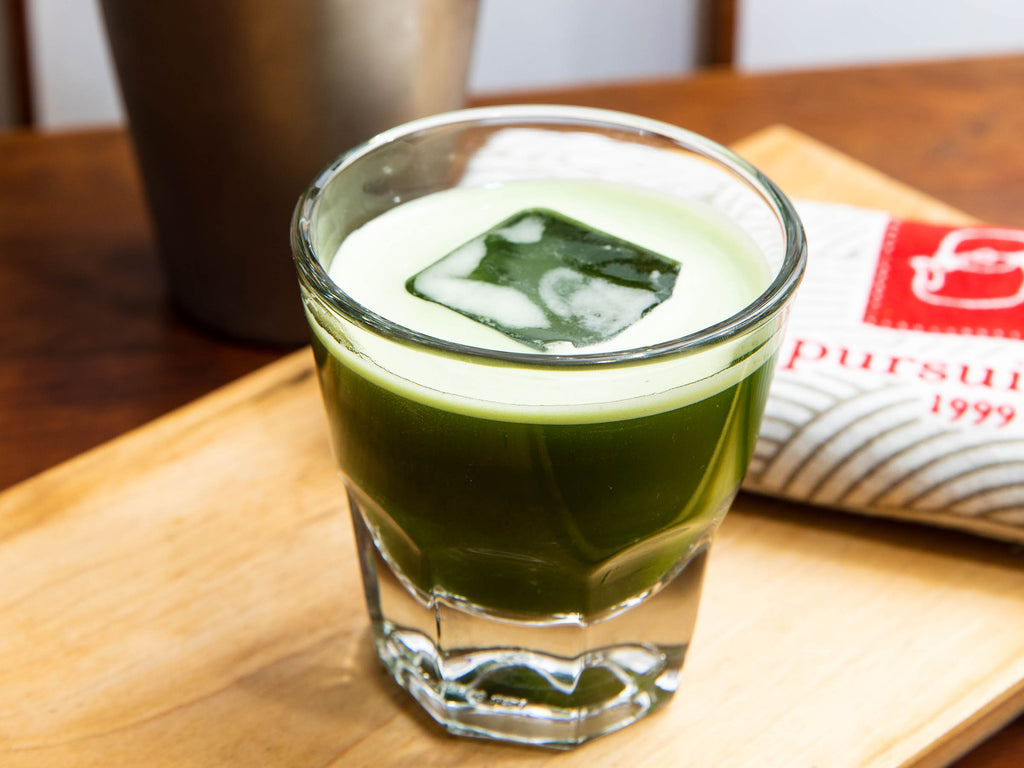The Tea Lover's Guide to Tea Cocktails

Many of us are not aware of the role tea has played in the history of the cocktail. Before the era of the individually mixed drink, 18th and 19th century imbibers in Western Europe were all about the punch bowl. This was especially the case for sailors on long ocean voyages, who kept crates of tea and citrus trees on their ships for the express purpose of making grogs to ward off scurvy (and possible mutiny).
These naval punches even came with handy pneumonic recipes: one of sour, two of sweet, three of strong, and four of weak. The sour was typically citrus juice; the sweet either sugar or molasses. Spirits were the strong (usually rum, brandy, or arrack); the weak, a water-based liquid, was often a robust brew of green or black tea.
It's a good stiff drink, that old naval punch, but we're happy to report that the use of tea in cocktails has become much more sophisticated in recent years. Tea is an oft-misunderstood cocktail ingredient. It can easily be overwhelmed by assertive mixers, or bombard a drink with excess tannin. If you follow a few simple methods, however, and don't mind some experimentation, teas and herbals can be used in a wonderful range of drinks with beguiling flavors and aromas.
First, a few basic principles
Loose tea, not teabags: "It's much easier to work with," says IPOT staffer and professional bartender John McGinley. McGinley has mixed many a tea cocktail in his day, and while he acknowledges that teabags are convenient, "you don't know much tea is in there. With looseleaf you can easily adjust your measurements." Each tea has its own strength when infused in a spirit or syrup, and small changes in ratios can make a big difference.
Lighter spirits for more tea character: "White spirits like vodka or blanco tequila will tend to reveal more of the tea's flavor," says our friend Estelle Bossy, the beverage director of the new Graduate Hotel on New York's Roosevelt Island. "For a dark spirit or sweet vermouth, you might want a bolder black tea, like Earl Grey with Scotch. Lighter spirits work well with white or green tea."
Keep it simple: It's easy to get carried away when making cocktails; before you know it, your drink has half a dozen ingredients and doesn't really taste like any of them. The goal of using tea in cocktails is to highlight a tea's unique flavor or support another ingredient. Less is more, and will help your drinks maintain focus.

The simplest approach: cocktails with brewed tea
The easiest way to start mixing with tea is to use whatever brewed tea you have already. We recommend making a speedy iced tea by brewing a hot double-strength infusion, then straining the tea over ice cubes. This is essentially the "weak" liquid from those historic punches, with ratios revised for modern cocktail-making. Cocktail author Martin Doudoroff uses this method with our Scarlet Glow for a tart, refreshing punch with rum, port, lemon juice, and simple syrup.
Brewed tea is also handy for making larger drinks with a lower alcohol content. PDT bar man Jim Meehan blends hot Chamomile with Scotch, St. Germain and honey for a cozy concoction that he garnishes with a lemon wedge studded with cloves. The toddy is served in a mug, and with twice the volume of chamomile as spirits, is easy to sip all evening.
You can also use brewed tea as the base for spirit-free drinks, which brings not just flavor, but the rich texture of a proper cocktail. "The difficulty with non-alcoholic drinks is the texture and mouthfeel," Bossy says. "That's something easily adjusted with a tea or tisane."
A little more advanced: tea syrups
Steeping tea leaves or herbals into a concentrated syrup allows you to make stronger, more balanced drinks with flavors that stand up to your main spirit. Tea takes to syrups especially well, and just about any variety works, though we've found that for the strongest flavor, it's best to add the sugar after your tea has finished brewing. Start with a concentrated hot brew of tea, then strain it into a measure of sugar. If you began your brew with a cup of water, use about a cup of sugar to make a basic simple syrup. How much tea you use for that syrup depends on the individual tea and your own goals, so don't be afraid to experiment. Any leftover syrup is always nice for stirring into sparkling water on a hot day.
A classic Last Word cocktail is made with equal parts gin, maraschino liqueur, green Chartreuse, and lime juice. As pre-Prohibition drinks go, it's just about perfect, though it requires some bottles you may not keep around all the time. John makes a version that replaces the green Chatreuse with a verdant sencha syrup. "When I'm developing a drink," he says, "I think, what's the base and how can I add a layer of flavor. I go through my mental Rolodex and see what I have. Green tea reminds me of herbaceous amari and Chartreuse."

The next level: infused spirits
"If you think about the fact that alcohol is a solvent, it makes sense that it's a more efficient vessel for infusing tea than hot water," Bossy explains. Just a few minutes or hours of steeping tea leaves in a spirit yields a vividly flavored infusion that doesn't require the sweetness of sugar. We've seen green tea vodka infusions, Scotch and Earl Grey, even white rum with White Peony.
The trick, Bossy says, is not to infuse for too long. Alcohol is such an effective solvent that it will pull all the tannins out of tea if left to its own devices. For Bossy, one to 10 minutes is plenty of time, and there's no need to infuse a whole bottle for one drink. Just set aside a few ounces of your spirit and sprinkle in the tea leaves, letting them steep while chilling the serving glasses and chopping your limes. Bossy recommends straining the infusion through the best filter you have. "Tea particles that pass through a fine mesh strainer will keep infusing. You need to strain out the solids very thoroughly."
Infusions are a powerful tool. Bossy makes one with Scotch and Earl Grey that she combines with an amaro and some Drambouie "for a Rusty Nail variation that's really bergamot-forward." And you're not just limited to hard liquor; aperitifs like vermouth also take well to infusion, though with their lower alcohol content they require a longer infusing time. Bossy recommends infusing dry vermouth with Jasmine Pearls for a delicately floral martini or spritz.
Just like with syrups, tea infusions require some trial and error. You'll need to dial in your tea dosage and infusion time depending on your ingredients and your goal for the spirit. But just like any brewing, you'll soon get an intuitive feel for what works—and that's when the real fun begins. Here are some recipes to get you started.

Chanterelle Ruby Punch
Recipe by Martin Doudoroff, based on Jerry Thomas’ How to Mix Drinks (1862)
Ingredients
- 2 oz white rum
- 1 oz brewed Scarlet Glow
- ¾ oz ruby port
- Lemon juice and simple syrup, to taste
Method
In a cocktail shaker, combine white rum, Scarlet Glow, and ruby port with ice. Shake thoroughly, then add lemon juice and simple syrup to taste. Serve over ice.
Le Pere Bis
Recipe by Jim Meehan, PDT
Ingredients
- 1½ oz Scotch
- ½ oz St. Germaine
- ½ oz clover honey
- 4 oz brewed Chamomile, hot
Method
Mix all ingredients in a large mug. Garnish with a lemon wedge studded with cloves.
Sencha Last Word
Recipe by John McGinley, In Pursuit of Tea
Sencha simple syrup
- 16 oz water
- 7 grams Sencha Fukamushi
- 12 oz sugar
Ingredients
- ¾ oz gin
- ¾ oz maraschino liqueur
- ¾ oz sencha simple syrup
- ¾ oz lime juice
Method
Heat water to 160°F and pour over sencha; let steep for 2 to 3 minutes. Strain and combine with sugar until sugar is completely dissolved. Chill syrup in refrigerator; store for up to one month.
In a cocktail shaker, combine gin, maraschino, sencha syrup and lime juice with ice. Shake thoroughly, then strain into a cocktail glass.
Pu-erh Old Fashioned
Recipe by John McGinley, In Pursuit of Tea
Pu-erh simple syrup
- 16 oz water
- 7 grams Shu Pu-erh Looseleaf 2016
- 12 oz sugar
Ingredients
- 1½ oz bourbon
- 1 oz pu-erh simple syrup
- 2 dashes Peychaud's bitters
Method
Boil water and pour over pu-erh; let steep 3 minutes. Strain and combine brewed tea with sugar until sugar is completely dissolved. Chill syrup in refrigerator; store for up to one month.
In a cocktail shaker, combine bourbon, pu-erh syrup and bitters with ice. Stir thoroughly, then strain into a rocks glass with a large ice cube.
Earl Grey Marteani
Recipe by Audrey Sanders
Earl Grey gin infusion
- 4 tablespoons Earl Grey
- 1 1-liter bottle of Tanqueray gin
Ingredients
- 1½ oz Earl Grey gin
- 1 oz simple syrup
- ¾ oz lemon juice
- 1 egg white
Method
Measure 4 tablespoons of loose Earl Grey into the bottle of gin. Replace cap and shake well to agitate. Allow tea to steep in gin for 2 hours, then strain thoroughly, but do not press on tea leaves, which can add unwanted bitterness.
In a cocktail shaker, combine Earl Grey gin, simple syrup, lemon juice, and egg white without ice. Shake thoroughly to combine. Add ice, then shake thoroughly again. Strain into a chilled cocktail glass that has been half-rimmed with sugar mixed with lemon zest. Garnish with a lemon twist.
